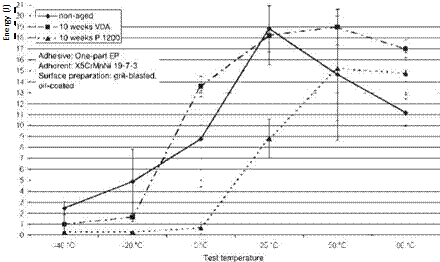In the car manufacturing industry, and especially in bodywork construction, bonding has been adopted as an increasingly successful joining technique. Consequently, the
 |
impact resistance ofbonded joints has become a matter of growing particular interest (see Section 8.2.2). In this field of application, considerably more attention must be concentrated on the deformation capacity of adhesives, especially during a crash, than on the tensile shear strength or peel strength, for example. The crash behavior can be tested on component-like specimens such as double hat boxes exposed to an impact load, although this requires a considerable testing effort. Hence, simpler tests performed on smaller specimens have been accepted as tried and tested methods. The most important one — the wedge impact test — is described in Section 7.3.2; typical results are shown in Figure 7.35.
In this example (special steel bonded with an epoxy-resin based adhesive for bodyworks), it can be seen that the energy absorption capability depends heavily on the temperature. In anticipation of Section 7.7.5, it can also be seen that there was a considerable change in the behavior ofbonded joints when they were exposed to a hostile environment prior to testing (see Section 7.4). Once again, the test results were seen to depend on the surface characteristics and surface conditions of the adherents. Whilst it is not possible to determine absolute parameters, these test results are useful for the comparison of different adhesives or, as in the above example, for the evaluation of crash behavior that changes under the influence of temperature and hostile environment.
7.7.5
 28 октября, 2015
28 октября, 2015  Pokraskin
Pokraskin  Опубликовано в рубрике
Опубликовано в рубрике 